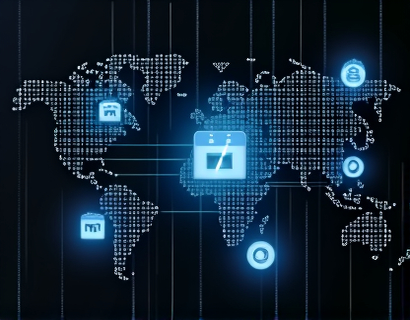Blockchain-Powered Asset Tokenization: Revolutionizing Market Accessibility and Liquidity for Real-World Assets
Blockchain technology is at the forefront of a transformative shift in asset management, enabling the seamless tokenization of real-world assets. This innovative approach not only enhances liquidity and market accessibility but also integrates physical assets into the digital ecosystem securely and efficiently. By leveraging blockchain, individuals and businesses can unlock new potentials, streamline transactions, and expand their market reach, all within a secure and trustworthy environment.
The concept of asset tokenization involves converting tangible assets such as real estate, art, infrastructure, and even intangible assets like intellectual property into digital tokens on a blockchain. These tokens represent fractional ownership or rights to the underlying asset, making it possible for a broader range of investors to participate in markets that were previously accessible only to a select few. This democratization of asset ownership is a significant step forward in financial inclusivity and market efficiency.
Enhancing Liquidity through Tokenization
One of the primary benefits of blockchain-powered asset tokenization is the enhancement of liquidity. Traditional real-world assets are often illiquid, meaning they cannot be easily bought or sold without significantly affecting their price. Tokenization changes this dynamic by allowing assets to be divided into smaller, tradable units. This divisibility means that even a small fraction of an asset can change hands, making it easier for investors to buy, sell, and trade without causing substantial price fluctuations.
For example, a commercial property worth millions can be tokenized into thousands or even millions of smaller tokens. Each token represents a fraction of ownership, allowing multiple investors to purchase and trade these tokens on various platforms. This process not only increases the number of potential buyers and sellers but also reduces the barriers to entry, thereby boosting market liquidity.
Improving Market Accessibility
Accessibility is another critical area where blockchain tokenization makes a significant impact. Traditionally, high-value assets require substantial capital to invest in, limiting participation to wealthy individuals or institutions. Tokenization lowers these barriers by allowing smaller investments through fractional ownership. This means that individuals with limited capital can now participate in high-value markets, diversify their portfolios, and gain exposure to assets they might otherwise find inaccessible.
Moreover, the global nature of blockchain ensures that these assets can be accessed and traded from anywhere in the world, 24/7. This global reach opens up new opportunities for investors who can now participate in markets that were previously geographically restricted. The removal of geographical barriers further enhances the liquidity and efficiency of asset markets.
Ensuring Security and Transparency
Security and transparency are foundational to blockchain technology and are crucial in the context of asset tokenization. Blockchain's decentralized and immutable ledger ensures that all transactions are recorded transparently and cannot be altered once confirmed. This immutability reduces the risk of fraud and enhances trust among participants in the market.
Smart contracts, self-executing contracts with the terms directly written into code, play a pivotal role in this process. They automate and enforce the rules of asset transactions, ensuring that all parties adhere to the agreed terms without the need for intermediaries. This not only reduces transaction costs but also minimizes the potential for disputes and errors.
Case Studies and Real-World Applications
Several notable projects and platforms are already leveraging blockchain tokenization to revolutionize asset management. One prominent example is RealT, a platform that tokenizes commercial real estate. RealT allows investors to buy, sell, and trade fractions of commercial properties using digital tokens on blockchain. This has democratized access to real estate investments, enabling a wider range of investors to participate in the market.
Another example is Basis Capital, which focuses on tokenizing art and collectibles. By tokenizing these assets, Basis Capital makes it possible for art enthusiasts and collectors to own fractions of high-value pieces, thereby increasing market liquidity and accessibility. This approach not only benefits individual investors but also provides artists and collectors with new revenue streams and exposure.
Infrastructure Tokenization
Infrastructure projects, such as bridges, roads, and utilities, are also being tokenized to attract investment and improve liquidity. For instance, the Tokenized Infrastructure Platform (TIP) allows investors to purchase tokens representing shares in infrastructure projects. This model not only provides a new way to fund large-scale projects but also allows for better risk distribution among investors.
These case studies demonstrate the versatility and potential of blockchain-powered asset tokenization across various sectors, from real estate and art to infrastructure and beyond.
Challenges and Considerations
Despite the numerous benefits, the tokenization of real-world assets is not without challenges. Regulatory frameworks are still evolving, and the lack of clear guidelines can create uncertainty for investors and issuers. Compliance with existing financial regulations and the development of new rules tailored to tokenized assets are critical for the sustainable growth of this market.
Technical challenges, such as scalability and interoperability, also need to be addressed. As the number of tokenized assets grows, blockchain networks must be able to handle increased transaction volumes efficiently. Additionally, ensuring that different blockchain platforms can work together seamlessly is essential for a cohesive and functional ecosystem.
Future Prospects
The future of blockchain-powered asset tokenization looks promising, with ongoing advancements in technology and regulatory clarity. As more institutions and individuals recognize the benefits of tokenization, adoption is likely to increase, driving further innovation and growth in the market.
One area of future development is the integration of tokenized assets with traditional financial instruments and platforms. This hybrid approach can enhance the functionality and appeal of tokenized assets, making them more accessible to a broader audience. Additionally, the exploration of decentralized finance (DeFi) applications for tokenized assets can unlock new possibilities for lending, borrowing, and yield generation.
Conclusion
Blockchain-powered asset tokenization is revolutionizing the way real-world assets are managed, traded, and invested in. By enhancing liquidity, improving market accessibility, ensuring security and transparency, and overcoming traditional barriers, this technology is opening up new opportunities for investors and asset holders alike. As the ecosystem continues to evolve, the potential for further innovation and growth remains vast, promising a more inclusive and efficient global asset market.










































